
English
Congratulations on your purchase, and welcome to Philips!
To fully benet from the support that Philips oers, register
your product at www.Philips.com/welcome.
1 What’s in the box
Fuzzy rice cooker main unit Steam basket
Rice scoop Soup ladle
Measuring cup User manual
Safety leaet Warranty card
Power cord
Overview
a
Fuzzy rice cooker
main unit
j
Lid release button
b
Power cord
k
Control panel
c
Rice scoop
l
Main body
d
Soup ladle
m
Power plug
e
Steam basket
n
Heating element
f
Measuring cup
o
Water level indications
g
Top lid
p
Cooker handle
h
Sealing ring
q
Inner lid
i
Inner pot
r
Detachable steam vent
cap
Controls overview
s
Preset time
w
Cook time
t
Time adjust
x
Reheat
u
Quick cook
y
O/Warm
v
Congee/Soup
z
Standard cook
Before rst use
1 Take out all the accessories from the inner pot. Remove
the sheet between the inner pot and the heating
element.
2 Clean the parts of the rice cooker thoroughly before
using the rice cooker for the rst time (see chapter
‘Cleaning’).
Note
• Make sure all parts are completely dry before you start using
the rice cooker.
Preparations before use
Before using the rice cooker, you need to follow the
preparation:
1 Measure the rice using the measuring cup provided.
2 Wash the rice thoroughly.
3 Put the pre-washed rice in the inner pot.
4 Add water to the level indicated on the scale inside the
inner pot that corresponds to the number of cups of rice
used. Then smooth the rice surface.
5 Press the release lever to open the lid.
6 Put the inner pot in the rice cooker. Check if the inner
pot is in proper contact with the heating element.
ga
b
c
d
h
i
j
k
l
n
o
p
f
q
r
m
Quick
cook
Time
adjust
Preset
time
Standard
cook
Off
Warm
Congee/
Soup
Reheat
Cook
time
s z
y
x
w
t
u
v
Standard
cook
Congee/
Soup
Time
adjust
Time
adjust
Standard
cook
Congee/
Soup
Reheat
1
www.philips.com/welcome
User manual
HD 3030
www.philips.com/welcome
Safety leaflet
HD 3030
www.philips.com/welcome
Warranty
HD 3030
What’s in the box
包装盒内物品
ภายในกลองมีอะไรบาง
Apa saja isi kemasannya
Apa dalam kotak ini
Using the fuzzy rice cooker
使用模糊控制电饭煲
การใชหมอหุงขาวระบบ Fuzzy
Menggunakan penanak nasi fuzzy Menggunakan pemasak nasi fuzzy
Rice cooking
煮饭
Menanak nasi Memasak nasi
Preset time for
delayed cooking
延长烹饪的预设时间
.
Waktu preset untuk
memasak yang ditunda
Masa dipraset bagi
masakan tertangguh
การตั้งเวลาสำหรับการทำ
อาหารไวลวงหนา
Cooking congee and making soup
煮粥和做汤
การตมโจกและการทำซุป
Memasak bubur dan membuat sup
Memasak bubur dan membuat sup
Reheating
加热
การอนรอน
Memanaskan Ulang Panas semula
e
1
2
3
4
5 6
7
8
9
1
2
EN User manual
HI
ID Buku Petunjuk Pengguna
MS Manual pengguna
TH คมือผใช
ZH-S
用户手册
7 Close the lid of the rice cooker, put the plug in the
power socket.
Note
• Each cup of uncooked rice normally gives 2 bowls of cooked
rice. Do not exceed the quantities indicated on the inside of
the inner pot.
• The level marked inside the inner pot is just an indication. You
can always adjust the water level for dierent types of rice and
your own preference. If the voltage is unstable at the area you
live, it is possible that the rice cooker overows.
• Besides following the water level indications, you can also add
rice and water at 1:1-1.2 ratio for rice cooking. Do not exceed
the quantities indicated on the inside of the inner pot.
• Make sure that the outside of the inner pot is dry and clean, and
that there is no foreign residue on the heating element or the
magnetic switch.
Rice cooking
There are two rice cooking functions for HD3030.
Cooking function Estimated cooking time for
6 cups of rice
Standard cook (
cook
) 50 minutes
Quick cook (
Quick
cook
) 38 minutes
Note
• Follow the same steps for Quick cook (
Quick
cook
).
• Do not exceed the volume indicated nor exceed the maximum
water level indicated in the inner pot, as this may cause the
rice cooker to overow.
• You can press the cancel button (
O
) or unplug the rice
cooker to turn o the keep warm function or when not in use.
Cooking congee and making soup
Cooking function Estimated cooking time
Cooking congee (
Congee/
Soup
) 1 hour (for
1
cup of rice)
Making soup (
Congee/
Soup
) 1 hour
Note
• Do not exceed the volume indicated nor exceed the maximum
water level indicated in the inner pot, as this may cause the
rice cooker to overow.
• You can press the cancel button (
O
) or unplug the rice
cooker to turn o the keep warm function or when not in use.
• It is normal to nd the congee more stickier if it is left in keep
warm mode for too long.
Tip
• Default cooking time is 1 hour.
Reheating
Cooking function Estimated cooking time
Reheating (
Reheat
)
25 minutes
Note
• You can press the cancel button (
O
) or unplug the rice
cooker to turn o the keep warm function or when not in use.
Preset time for delayed cooking
You can preset the delayed cooking time for rice, congee,
and soup. The preset timer is available up to 24 hours.
Note
• Do not exceed the volume indicated nor exceed the maximum
water level indicated in the inner pot, as this may cause the
rice cooker to overow.
• Once the rice cooker enters preset mode, the preset time
button (
time
) will not respond.
• You can press the cancel button (
Warm
) or unplug the rice
cooker to turn o the keep warm function or when not in use.
2 Cleaning and Maintenance
Note
• Uplug the rice cooker before starting to clean it.
• Wait until the rice cooker has cooled down suciently before
cleaning it.
Interior
Inside of the outer lid and the main body:
• Wipe with wrung out and damp cloth.
• Make sure to remove all the food residues stuck to the
rice cooker.
Heating element:
• Wipe with wrung out and damp cloth.
• Remove food residues with wrung out and damp cloth
or toothpicks.
Exterior
Surface of the outer lid and outside of the main body:
• Wipe with a cloth damped with soap water.
• ONLY use soft and dry cloth to wipe the control panel.
• Make sure to remove all the food residues around the
control buttons.
Accessories
Rice scoop, soup ladle, inner pot, steam basket, and steam
vent cap:
• Soak in hot water and clean with sponge.
3 Environment
Do not throw away the appliance with normal household
waste at the end of its life, but hand it in at an ocial
collection point for recycling. By doing this, you can help to
preserve the environment.
4 Guarantee and service
If you need service or information, or if you have a
problem, visit the Philips website at www.philips.com or
contact the Philips Customer Care Center in your country.
You can nd its phone number in the worldwide guarantee
leaet. If there is no Customer Care Center in your country,
go to your local Philips dealer.
5 Troubleshooting
If you encounter problems when using this rice cooker,
check the following points before requesting service. If you
cannot solve the problem, contact the Philips Consumer
Care Center in your country.
Problem Solution
The lights on
the buttons
does not go
on.
There is a connection problem. Check
if the power cord is connected to
the cooker properly and if the plug is
inserted rmly into the power outlet.
The light is defective. Take the
appliance to your Philips dealer or a
service center authorized by Philips.
The display
does not
function.
The rice cooker is not connected to
the power supply. If there is no power
supply, the power failure backup
function does not work and the display
does not function.
The battery for the display runs out
of power. Take the appliance to your
Philips dealer or a service center
authorized by Philips to have the
battery replaced.
The rice is not
cooked.
There is not enough water. Add water
according to the scale on the inside of
the inner pot.
You did not press the cooking function
button.
Make sure that there is no foreign
residue on the heating element and
the outside of the inner pot before
switching the rice cooker on.
The heating element is damaged, or the
inner pot is deformed. Take the cooker
to your Philips dealer or a service center
authorized by Philips.
The cooker
does not
switch to keep
warm mode
automatically.
The temperature control is defective.
Take the appliance to your Philips
dealer or a service center authorized
by Philips.
The rice is
scorched.
You have not rinsed the rice properly.
Rinse the rice until water runs clear.
Water spills
out of the rice
cooker during
cooking.
• Make sure that you add water to
the level indicated on the scale
inside the inner pot that cor-
responds to the number of cups of
rice used.
• Make sure the water does not
exceed the next level on the scale,
as this may cause the appliance to
overow during cooking.
Rice smells
bad after
cooking
Clean the inner pot with some washing
detergent and warm water.
After cooking, make sure the steam vent
cap, inner lid and inner pot is cleaned
thoroughly.
Error message
(E1, E2, E3, or
E4) appears on
the display.
There has been a power failure during
cooking. Take the appliance to your
Philips dealer or a service center
authorized by Philips.
Philips !
Philips ,
www.Philips.com/welcome .
1
a
j
b
k
c
l
d
m
e
n
f
o
g
p
h
q
i
r
s
w
t
x
u
y
/
v
/
z
1 .
.
2
( ‘’ ).
•
.
, :
1 .
2 .
3 .
4
. .
5 .
6 .
.
7 , .
• 2 .
.
• .
.
.
• , 1:1-
1.2 . .
• ,
.
HD3030 .
6
(
cook
)
50
(
Quick
cook
)
38
• (
Quick
cook
).
• ,
.
• (
O
)
.
(
Congee/
Soup
)
1 (
1
)
(
Congee/
Soup
)
1
• ,
.
• (
Warm
)
.
•
.
• 1 .
(
Reheat
)
25
• (
O
Warm
)
.
.
, , .
24 .
• ,
.
• , (
time
)
.
• (
Warm
)
.
2
• .
• .
:
• .
• .
:
• .
• .
:
• .
• .
• .
, , , :
• .
3
.
.
4
Philips
www.philips.com Philips
. .
Philips .
5
.
Philips .
.
.
.
. Philips Philips
.
.
.
,
.
.
Philips Philips
.
. .
.
.
.
, .
Philips Philips
.
.
. Philips
Philips .
. .
.
.
•
.
•
,
.
.
, ,
.
(E1, E2,
E3, E4)
.
.
Philips Philips
.
Indonesia
Selamat atas pembelian Anda dan selamat datang di
Philips!
Untuk memanfaatkan sepenuhnya dukungan yang
ditawarkan Philips, daftarkan produk Anda di
www.Philips.com/welcome.
1 Apa saja isi kemasannya
Unit utama penanak nasi fuzzy Keranjang kukus
Sendok nasi Sendok sup
Gelas takar Petunjuk Pengguna
Brosur keselamatan Kartu garansi
Kartu garansi
Ikhtisar
a
Unit utama penanak
nasi fuzzy
j
Tombol pembuka tutup
b
Kartu garansi
k
Panel kontrol
c
Sendok nasi
l
Badan utama
d
Sendok sup
m
Steker listrik
e
Keranjang kukus
n
Elemen pemanas
f
Gelas takar
o
Indikator ukuran air
g
Tutup luar
p
Pegangan penanak
h
Gelang penyegel
q
Tutup bagian dalam
i
Panci bagian dalam
r
Tutup lubang uap lepas-
pasang
Ikhtisar kontrol
s
Waktu preset
w
Waktu memasak
t
Setelan waktu
x
Memanaskan
u
Memasak cepat
y
Off/Hangat
v
Bubur/Sup
z
Memasak standar
Sebelum menggunakan alat pertama kali
1 Lepaskan semua aksesori dari panci bagian dalam.
Lepaskan lapisan antara panci bagian dalam dan
elemen pemanas.
2 Bersihkan semua bagian penanak nasi secara saksama
sebelum menggunakan penanak nasi untuk pertama
kali (lihat bab ‘Membersihkan’).
Catatan
• Pastikan semua bagian benar-benar kering sebelum Anda
mulai menggunakan penanak nasi.
Persiapan sebelum menggunakan
Sebelum menggunakan penanak nasi, Anda perlu
mengikuti persiapan berikut:
1 Takar nasi dengan menggunakan gelas takar yang
sudah disediakan.
2 Cuci beras sampai bersih.
3 Masukkan beras yang sudah dicuci sebelumnya ke
panci bagian dalam.
4 Tambahkan air sampai ukuran yang ditunjukkan pada
skala di bagian dalam panci sesuai jumlah gelas takar
beras yang digunakan. Lalu ratakan permukaan beras.
5 Tekan tuas pelepas untuk membuka tutupnya.
6 Masukkan panci bagian dalam pada penanak nasi.
Pastikan panci bagian dalam telah bersentuhan dengan
elemen pemanas secara tepat.
7 Tutuplah tutup penanak nasi, lalu pasang steker ke soket daya.
Catatan
• Setiap gelas takar yang berisi beras yang belum dimasak
biasanya dapat menghasilkan 2 mangkuk nasi. Jangan
melebihi jumlah yang ditunjukkan pada panci bagian dalam.
• Ukuran yang ditunjukkan di panci bagian dalam hanya sebagai
indikasi saja. Anda dapat menyesuaikan ketinggian air untuk
jenis beras yang berbeda dan preferensi Anda. Jika voltase
tidak stabil di daerah tempat Anda tinggal, ada kemungkinan
penanak nasi akan meluap.
• Selain mengikuti indikasi batas air, Anda juga dapat
menambahkan beras dan air dengan rasio 1:1-1,2 saat
memasak nasi. Jangan melebihi jumlah yang ditunjukkan
pada panci bagian dalam.
• Pastikan bagian luar panci bagian dalam sudah kering dan
bersih, dan tidak ada benda apa pun pada elemen pemanas
atau sakelar magnetik.
PHILIPS
PENANAK NASI
Model: HD3030
Power: 650W
Listrik: 220V ~ 50Hz
Negara Pembuat: China
Diimpor oleh:
PT Philips Indonesia Commercial
JI Buncit Raya Kav 99 Jakarta
12510
Indonesia
I.21.PIC2.02601.1213
HD3030
©2017 Koninklijke Philips N.V.
All rights reserved.
HD3030_UM_V4.0

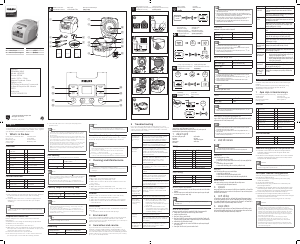


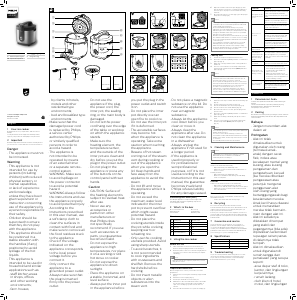
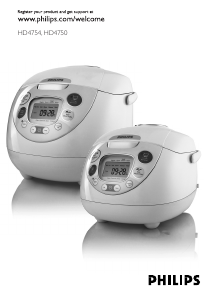
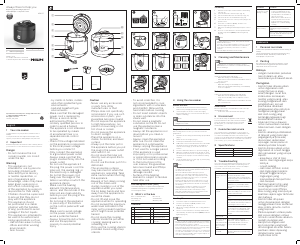
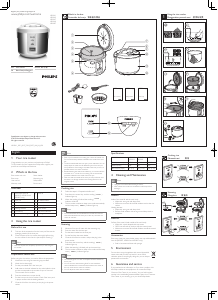

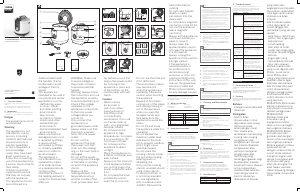
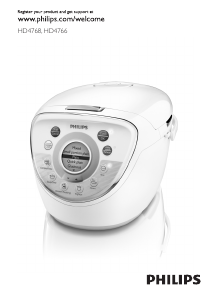

Bergabunglah dalam percakapan tentang produk ini
Di sini Anda dapat membagikan pendapat Anda tentang Philips HD3030 Penanak Nasi. Jika Anda memiliki pertanyaan, bacalah panduan dengan cermat terlebih dahulu. Meminta panduan dapat dilakukan dengan menggunakan formulir kontak kami.